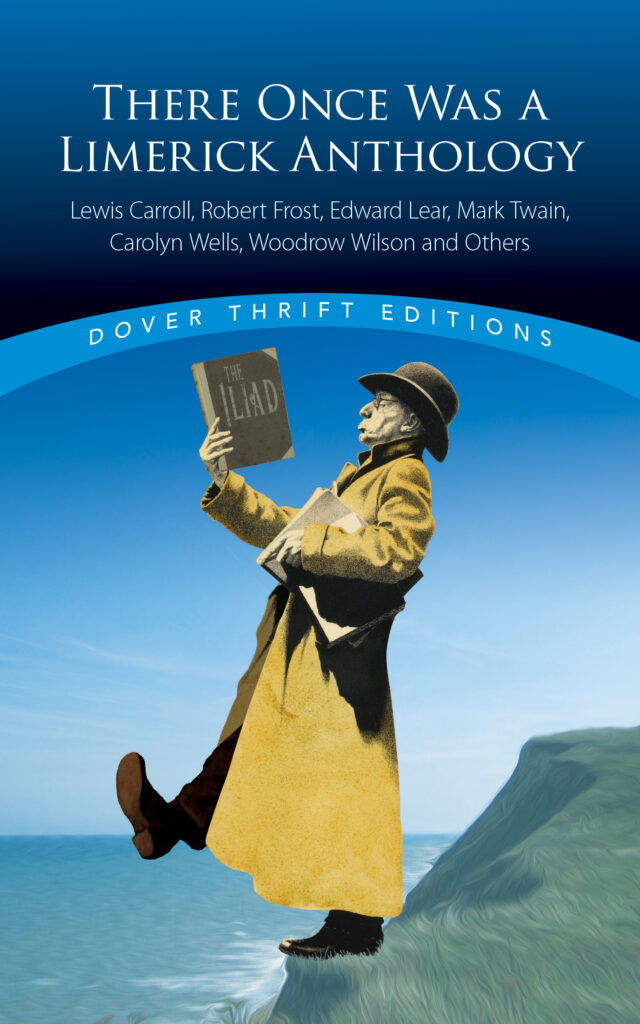Limerick anthologies have been around for more than a century. I compiled There Once Was a Limerick Anthology, which is out today from Dover Publications. What makes this book different?
My anthology is part of the Dover Thrift Editions series, which aims to be a “carefully curated library of the world’s greatest literature.” I didn’t necessarily include limericks that are the most commonly anthologized or that a comedian might recite aloud in order to get a cheap laugh. I portrayed limericks as poetry—as literature.
I organized the chapters according to this guiding principle. While I did encounter at least one other anthology with a chapter devoted to tongue twisters, my anthology might be unique in having specific chapters devoted to names (e.g., “There was a young lady named Kate”), quotations, creative misspellings, and creative abbreviations. For example, many people are familiar with clean or dirty versions of this limerick by Dayton Voorhees:
There once was a man from Nanctucket Who kept all his cash in a bucket, But his daughter, named Nan, Ran away with a man, And as for the bucket, Nantucket.
The creative misspelling at the end—a pun on “Nan took it”—is part of a larger context of creative misspellings in limericks. “Geographical Limericks” and “Creative Misspellings” are the longest chapters in the book, and it made sense to include the Nantucket selection in the latter rather than presenting it as a straightforward geographical limerick. Because the content is organized in this way, readers can appreciate the wordplay and poetic devices that are common in different varieties of limericks. Indeed, many selections are impressive from a literary perspective.
The other key distinction about There Once Was a Limerick Anthology is that it tries not to offend readers. A reader should not feel like the butt of the joke because of his or her sex, race, religion, or other group. Here is a note that I included in the book’s introduction:
Humor is subjective. In selecting the material, the editor favored ingenious rhymes and puns over offensive content that might have gotten a bigger laugh out of some readers.
In a bygone era, many limericks portrayed women and different races, ethnicities, and religions in a demeaning light, sometimes with appalling slurs. The implicit message was that the poets, typically white and male, could freely disparage others in the name of comedy. That approach has not stood the test of time.
This anthology steers clear of misogyny, racism, homophobia, and transphobia. . . . To be sure, many selections deride individual fictional characters. However, they should not be seen as representative of their sex, nationality, or other group.
In the twenty-first century, humorists should consider the impact of their words and err on the side of caution and respect.
Even the bawdy limericks chapter adheres to some standards of decency. I explained at the beginning of the chapter, “Sexual acts involving multiple people must be consensual. The most offensive curses are avoided. Misogyny, racism, homophobia, and transphobia are eschewed. What’s left is lewdness that will satisfy readers who crave vulgar humor—and disgust those who do not.” For example, one bawdy limerick I encountered had a scintillating rhyme, but after considering what the content said, I was not convinced that the sex act depicted was consensual. That limerick is not in the book.
You can call it being politically correct. I call it being decent to other people. That is an important quality that is sorely lacking in many anthologies from yesteryear. The limericks that made the cut are pretty hilarious without having to stoop to being sexist, racist, etc.


1 Comment
Madeleine Begun Kane
August 24, 2022 at 3:11 amCongratulations, and good luck with sales! It certainly sounds like a fun read!